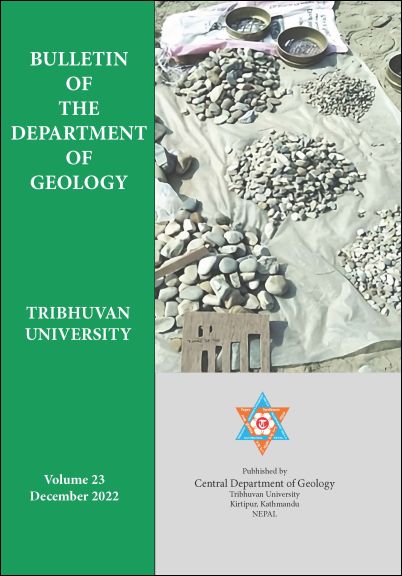Landslide Susceptibility Assessment Using GIS-Based Weights-of-Evidence Model in the Khimti Khola Watershed, Eastern Nepal
DOI:
https://doi.org/10.3126/bdg.v23i1.64776Keywords:
Landslides, Weights-of-Evidence Model, Landslide Susceptibility Assessment, Khimti Khola Watershed, Eastern NepalAbstract
The Khimti Khola watershed of the Eastern Nepal experiences numerous landslides each year, pose a significant natural hazard that can cause property damage and fatalities. In mountainous areas like Nepal, an accurate evaluation of landslide hazards may be an essential tool for disaster risk reduction and the strategic planning of development initiatives. To address this concern, a landslide susceptibility assessment was conducted in the Khimti Khola watershed, which covers an area of 440 km2. The purpose of this assessment is to locate areas that are susceptible to landslides and to provide light on the factors that affect them. A total of 415 landslides were identified, covering 1.715 km2 or 0.39% of the entire study area. The assessment derived the landslide susceptibility map using the Weights-of-Evidence (WoE) model from selected conditioning factor classes that were processed in ArcGIS and categorized into five classes: Very High, High, Moderate, Low, and Very Low. Each of these classes covers 7.12%, 16.63%, 25.23%, 30.24%, and 20.78% of the total study area, respectively. According to the findings, the Khimti Khola watershed has a 33.2% landslide occurrence percentage in the high susceptibility zone, out of the total area. Additionally, the very high, moderate, low, and very low susceptibility zones cover 24.35%, 20.75%, 17.08%, and 4.62% area of the landslide occurrence, respectively. In this assessment, the Area Under Curve (AUC) is used to validate the model and is plotted using ArcSDM. Identified a total of 415 landslides, out of which 311 (75%) were used as training sample for susceptibility mapping, while the remaining 104 (25%) were used to validate. The AUC for the landslide susceptibility map is 83%, indicating a very good degree of accuracy and satisfaction. The resulting susceptibility map provides information for predicting landslide-prone areas. It can be used to minimize the risk of potential landslides, safeguard lives, and prevent property damage. It will be a vital tool for disaster preparedness, future construction planning and development projects in this area.
Downloads
Downloads
Published
How to Cite
Issue
Section
License
© Central Department of Geology, Tribhuvan University, Nepal

